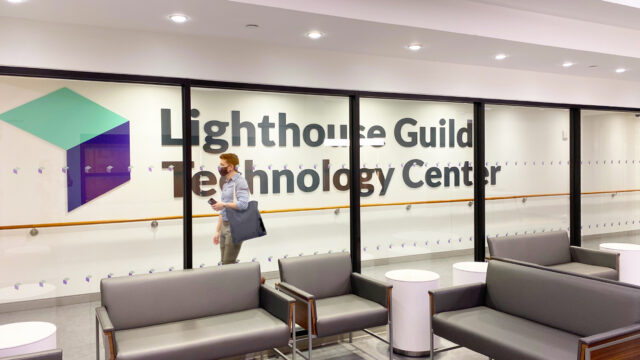Technology Center Q&A

Who is the Technology Center For?
- People who are visually impaired as well as ANYONE who needs help using technology.
- Technology developers
What does the Technology Center offer?
- Assessments by Lighthouse Guild experts to determine visual capacity, lifestyle, personal goals, and comfort with technology.
- Opportunities to try out and learn how to use cutting-edge and basic technology devices.
- Solutions such as: wearable devices that convert text to speech, recognize faces, and identify currency; devices that use virtual reality technology to maximize useful vision; magnifiers, CCTVs, computers, and eyeglasses.
- A Smart Home setting featuring a kitchen, office and laundry room where people can try the latest technology that controls these home environments. Technology such as the ability to change the thermostat, turn lights on and off, answer the phone, lock doors and run appliances.
- Training by our experienced adaptive technology specialists and occupational therapists.
- Devices to purchase
- Installation assistance for setting up technology in the home.
- Continuing education for professionals who train people with vision impairment on devices
- A dedicated work space for developers, entrepreneurs, academics and physicians. They will have the opportunity collaborate with Lighthouse Guild experts on accessible technology and test their innovative designs.
Is the Technology Center a Store?
No. The technology center is a state-of-the-art facility where people with vision impairment can learn about the latest technology that will best fit their needs. Lighthouse Guild vision experts work with you to determine visual capacity, lifestyle, personal goals, and comfort with technology, provide an array of technology options — from high tech to low tech — to try and help you make the best decision based on your individual circumstances, sources of funding and your budget. Follow-up training sessions may be recommended to insure proper and optimal use of the device.
Some devices are available for purchase once a user has been properly assessed and trained.
What is the Assessment Process?
Step 1: A Low Vision evaluation by a vision specialist to assess your needs, offer recommendations and write a referral for an Occupational Therapy/Technology Evaluation at Lighthouse Guild. We recommend that this evaluation be conducted by one of Lighthouse Guild’s Low Vision Optometrists, who have specialized training and are well versed in the latest technological devices. However, your current eye care specialist (usually an Ophthalmologist) can also compete our referral form for a direct referral to Occupational Therapy (if we still recommend an evaluation by one of our Low Vision Optometrists, we will be in touch with you).
- If you wish to schedule an appointment for a Low Vision evaluation with a Lighthouse Guild vision specialist select the button below.
Make a low vision exam appointment
- If your eyecare specialist has evaluated you and you wish to have them provide a referral for Occupational Therapy/Technology Evaluation at Lighthouse Guild, you can download a blank referral form by selecting the button below.
Once you have your doctor complete and sign the form it needs to be faxed to Lighthouse Guild at 212-769-7825
We will contact you to schedule the appointment once we receive the completed referral signed by your eyecare specialist.
Step 2: A technology evaluation by a Lighthouse Guild Occupational Therapist (OT). The OT will meet with you for 60 minutes to assess your needs and preferences regarding technology and show you devices that may help. We will help you make the best decision based on your individual circumstances and your budget. Follow-up sessions may be recommended to ensure proper and optimal use of the device.
The technology that can best help you may not be high tech. Some people may benefit the most from a simple magnifier or smartphone app, while others may benefit from advanced technology such as a pair of high-resolution smart glasses.
What is Occupational Therapy?
Occupational therapy, commonly called OT, is a form of therapy for people with temporary or permanent disabilities that uses rehabilitation to restore or improve skills necessary for everyday activities.
Occupational therapy plays an important role in helping people with visual impairments. People with vision loss can be missing a part of the world around them, and occupational therapy can teach them new strategies to help to compensate for what they have lost.
Using rehabilitation techniques, an OT can help people with eye diseases, such as macular degeneration, glaucoma, diabetic retinopathy and genetic conditions, such as retinitis pigmentosa.
Techniques include education on safety during daily activities and setting up modifications of home environments, as well as evaluation and training on the use of low vision devices or aids — magnifiers, lighting and electronic magnification, voiceover and other technological devices.
Occupational therapy teaches strategies and techniques to compensate for loss of visual field, depth perception, increased glare, decreased contrast and color sensitivity. OT also offers visual skills training, such as visual fixation, visual scanning, tracking, conversion, eccentric viewing to name a few.
Learn more about Occupational Therapy
Are Occupational Therapy Evaluations Covered by Insurance?
Occupational Therapy evaluations are covered at least in part by most insurance plans. Your plan may require a co-pay for this visit.
The New York State Commission for the Blind and Visually Disabled (NYSCB) does NOT cover Occupational Therapy.
Join our Mission
Lighthouse Guild is dedicated to providing exceptional services that inspire people who are visually impaired to attain their goals.
